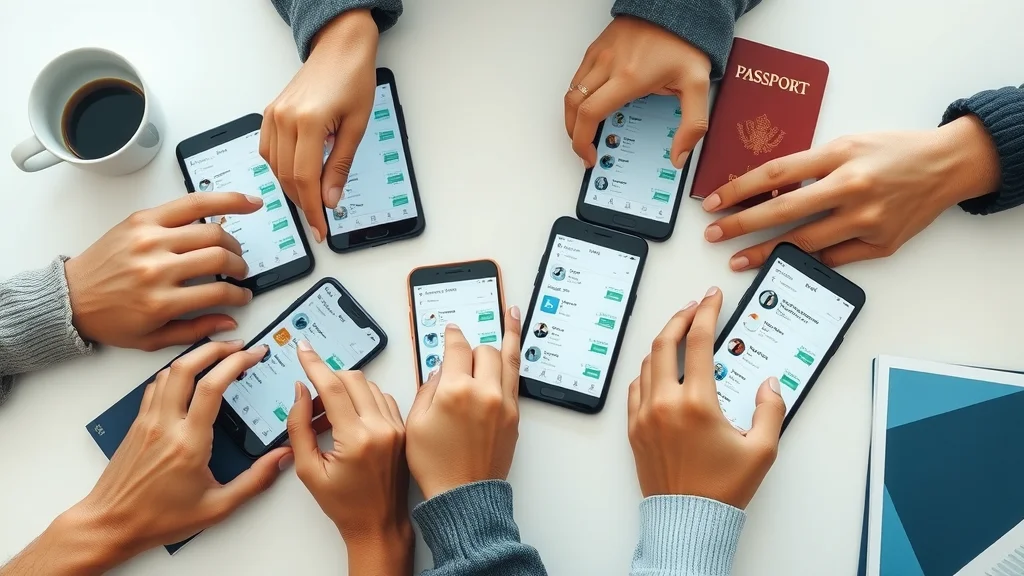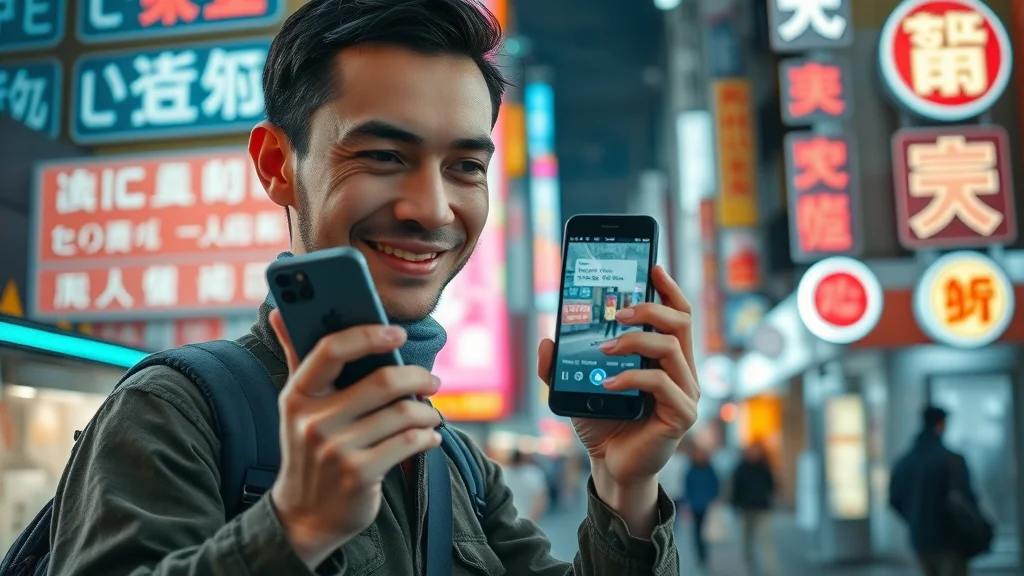Did you know over 1 billion international travelers now depend on language translation apps to explore the world? These digital tools are not just convenient—they're fundamentally transforming the way we experience new cultures, connect with locals, and overcome language barriers. Whether you're shopping in a bustling Marrakech bazaar, asking directions in Tokyo, or ordering food off a Spanish menu, the right translator app ensures language never holds you back. If you're planning any global adventure, this guide will show you how cutting-edge translation apps can revolutionize your travel experience—and which ones truly stand out.
Revolutionizing Travel: How Language Translation Apps Bridge Cultures
Language translation apps have become the indispensable travel companions of our era, removing language barriers and making the world feel smaller and more welcoming than ever. In the past, limited language skills or thick phrasebooks often meant frustration, miscommunication, and missed opportunities. Now, with an advanced translation app on your smartphone, you can communicate seamlessly in virtually any foreign language, unlocking new friendships, richer cultural exchanges, and hassle-free navigation wherever you roam.
These powerful translation tools harness machine learning and near-instant voice, text, and camera translation features. By bridging cultures, they foster more authentic interactions and help travelers confidently order food, seek help, shop, and immerse themselves in the local scene. Modern language translation apps support dozens—sometimes over a hundred—languages, offer real-time conversation support, and often work even when you're offline. The result? A deeper, more memorable travel experience where every interaction, no matter the language, becomes a meaningful adventure.

A Surprising Statistic: Over 1 Billion Travelers Now Rely on Language Translation Apps
According to recent industry studies, the number of global travelers using language translation apps has soared past the 1 billion mark. This remarkable figure highlights just how pivotal these digital solutions have become for today’s explorers. As more people discover the benefits of instant translations—especially real-time conversation and visual translation—reliance on these apps continues to grow across every continent.
This trend is driven by improved app support, faster processors, and expanding language databases, making apps like Google Translate, Microsoft Translator, and Apple Translate standard travel gear. Language translation apps not only empower individuals to handle more complex travel scenarios but also make international adventures accessible to everyone, including solo travelers, families, and business professionals venturing outside their native language comfort zones.
Why Language Translation Apps Have Become Essential for Modern Travelers
Several core reasons have made language translation apps absolutely essential on every traveler’s packing list. First and foremost, they provide instant solutions to the common anxiety of language barriers, whether it’s navigating public transit in Tokyo or ordering a meal in rural Italy. With powerful offline mode capabilities, many top apps allow communication even without internet access, so you’re never stranded in a foreign setting.
Additionally, these apps now offer much more than simple text translation—they include integrated speech recognition, camera-based translation for signs and menus, and even language coaching for correct pronunciation. These features deliver a human touch in bridging cultures, ensuring smoother interactions and meaningful engagement with locals. Ultimately, it’s this life-improving versatility that explains their meteoric rise among everyone seeking confident, independent, and enriching global travel.
What You'll Learn About Language Translation Apps
- The top-rated language translation apps for travelers
- Comparison of key features, pricing, and usability
- How translator apps enhance real-time communication
- Tips for choosing the ideal translation app for your needs
Understanding Language Translation Apps: Key Features and Capabilities
The world of language translation apps is dynamic and packed with innovative features designed to meet every traveler’s needs. From seasoned globetrotters to first-time explorers, understanding the core capabilities of these apps will help you select the perfect digital companion for your adventure. Most leading translator apps are available for both iOS and Android devices and offer an intuitive user interface that eliminates steep learning curves.
A great translation app does more than just convert words—it helps you connect. Key features like real-time voice translation, instant camera-based text translation, and broad language support ensure you can communicate effectively, whether you're bartering in a marketplace or making friends at an international hostel. Offline mode is a true game-changer, enabling you to use translation tools even when your phone has no signal, making these apps indispensable for both urban and off-grid adventures.
What Makes a Great Language Translation App?
When evaluating a language translation app, there are several core qualities that set the best apart. Real-time translation capabilities are a must-have, allowing you to join conversations as they happen or get instant help with queries and directions. Diverse language support means better global usability, while offline functionality is crucial for international travel where roaming charges or limited coverage are common.
Versatility in input methods marks another key feature—leading apps provide speech, text, and image translation, letting users scan menus, signs, or speak phrases on the go. Finally, seamless app support for both iOS and Android platforms ensures broad accessibility, so your translation app travels with you, no matter your device.

- Real-time translation capabilities
- Variety of supported languages
- Offline mode for global travelers
- Speech, text, and image translation functions
- App support for both iOS and Android
Top Language Translation Apps for Travelers: Comparison Guide
The right translation app for you depends on your destination, preferred features, and budget. To help make your decision easier, we’ve compared the top apps below based on their key features, supported languages, offline mode, and pricing. Modern apps like Google Translate, Microsoft Translator, Apple Translate, and others now offer nuanced features that bring a human touch into digital communication, simulating the expertise of professional translators.
Consider compatibility with your device, whether you need a free version or require premium capabilities, and the languages you expect to encounter. With this table, you’ll get a snapshot view to help you quickly compare and choose the best language translation app for every trip.
| App Name | Key Features | Pricing | Supported Languages | Offline Support |
|---|---|---|---|---|
| Google Translate | Text, Voice, Photo, Conversation, Offline Mode | Free | 133+ | Yes |
| Microsoft Translator | Text, Voice, Camera, Conversation, Multi-Device | Free | 100+ | Yes |
| Apple Translate | Text, Voice, On-device, Conversation | Free (Apple devices) | 20+ | Yes |
| iTranslate | Text, Voice, Camera, Phrasebook, Apple Watch | Free / $5.99/mo Pro | 100+ | Yes (Pro) |
| TripLingo | Text, Voice, Simultaneous Translation, Cultural Tips | Free / $19.99/mo Premium | 100+ | Partial |
| Papago | Text, Voice, Image, Conversation, Handwriting | Free | 13 (East Asian focus) | Yes |
Spotlight Review: Google Translate as a Translation App
Google Translate stands out as one of the most recognized and trusted language translation apps available free to users worldwide. Its combination of adaptability, intuitive user interface, and robust offline mode capabilities has made it a ubiquitous travel companion for millions. Whether you need quick text translation, conversation mode, or instant camera-based translations, Google Translate remains the benchmark in the translation app ecosystem.
The app’s neural machine translation engine continues to improve accuracy and context, making sure translations sound natural and local. Google’s vast resources and commitment to global connectivity mean you get continual updates, new language packs, and strong app support even in remote regions—an unmatched advantage for travelers facing tricky foreign language situations.
Key Features of Google Translate
Google Translate offers a suite of powerful key features that cater to every need a traveler might have. The text translation function supports over 133 languages, while the camera mode allows users to instantly translate printed signs, menus, or documents—simply point and read. The voice translation and real-time conversation modes are invaluable for direct communication, especially in fast-moving environments like airports or markets.
Another standout feature is the app’s offline mode. Simply download your target language pack before you leave home, and you can access reliable translation tools anywhere, even without data. Google Translate’s interface is simple enough for beginners while versatile enough for seasoned travelers, ensuring that you always have the right words—no matter where in the world you find yourself.

Pros and Cons of Google Translate for Travelers
Pros: Google Translate’s strengths lie in its expansive language selection, consistently improving accuracy due to its machine learning updates, and versatile input options including text, voice, and camera features. The robust offline mode, free access, and seamless app support make it the go-to choice for most travelers needing quick and reliable translations anywhere in the world.
Cons: However, even the most advanced translation app has its downsides. Certain language pairs—especially those with less digital data—may produce less accurate translations, and nuanced context or local slang can sometimes be lost. While the app works great for daily travel tasks, it doesn’t fully replace the human touch of professional translators for complex, professional, or sensitive communication. Still, for the vast majority of travelers, Google Translate’s advantages far outweigh any limitations.
Beyond Google Translate: Other Leading Language Translation Apps
While Google Translate is often the first choice for many, there’s a world of other remarkable translation apps to consider—each with their own unique strengths. Depending on your operating system, the languages you need, and specific travel requirements, other apps like Microsoft Translator, Apple Translate, and specialized tools like Papago and iTranslate offer competitive features and a polished user interface.
Exploring these alternatives is especially valuable if you’re seeking advanced conversation modes, offline phrasebooks, regional language support, or integrations with wearables like the Apple Watch. Many also offer premium tiers, giving access to professional-grade translations and customer support for business travelers or longer-term use.
Spotlight: Microsoft Translator App
Microsoft Translator is a robust and reliable competitor that shines with its multi-device support, broad language coverage, and collaborative features. Its real-time conversation mode can connect multiple users across different devices, making it invaluable for group travel, guided tours, or professional meetings. The app’s speech and camera translation capabilities handle everything from quick conversations to translating signs on the go.
With strong offline mode options and free access, Microsoft Translator is especially favored by travelers already invested in the Microsoft ecosystem. Notably, it also offers phrasebooks and pronunciation guides, blending digital efficiency with essential language learning tools.
Spotlight: Apple Translate App
Apple Translate is designed for Apple device users, offering a beautifully simple user interface that integrates seamlessly into the iOS environment. While the supported languages list is smaller than some competitors, the app focuses on accuracy, privacy, and ease-of-use. Offline access is standard, ensuring translations are always available—even without a connection.
The conversation mode is intuitive, and the app maintains a strong human touch by emphasizing natural language use and on-device translation for greater privacy. Integrated deeply with other iOS apps and even the Apple Watch, Apple Translate is the go-to choice for travelers devoted to the Apple ecosystem.

Other Highly-Rated Translation Apps for International Travel
- iTranslate
- TripLingo
- SayHi
- Papago
How Language Translation Apps Work: Behind the Scenes of Translation Technology
At the core of every efficient language translation app lies a blend of advanced technology—especially natural language processing (NLP) and machine learning. These sophisticated algorithms analyze millions of sentence examples, language structures, and user corrections to deliver more accurate translations with every update. This means modern translation apps can understand not just individual words, but the context and intent behind phrases—a quantum leap from the old dictionary-based tools.
With ongoing advances in artificial intelligence, neural machine translation systems learn from a vast pool of language data, so each translation improves over time. Camera translation, which analyzes and converts text directly from images, and speech-to-text functions that transcribe and translate spoken word, are made possible by this ever-evolving tech. All these components work together to ensure that your translation app is a powerful travel companion in nearly any scenario.
Natural Language Processing and Machine Learning
Natural language processing (NLP) and machine learning form the backbone of today’s best translator apps. NLP allows apps to understand not only the words but the grammatical structures and idiomatic expressions unique to each source language. This enables real-time adaptation and contextual accuracy, which is vital when dealing with everyday conversation or complex instructions.
Machine learning ensures that the more travelers use these apps, the better they become. User corrections, new text inputs, and emerging slang or technical terms are analyzed by the translation tool’s AI, refining the database and improving the accuracy of each translation. As a result, your app’s effectiveness grows over time—a huge advantage for frequent flyers and casual tourists alike.

Ensuring Accuracy and Security in Translation Apps
While machine learning enhances translation quality, ensuring accuracy and data privacy is paramount. Top-rated language translation apps like Google Translate and Microsoft Translator invest heavily in encrypted connections and clear user data policies. Always check whether your app stores or processes data on-device (for better privacy) or in the cloud. For sensitive business or personal information, look for settings that restrict app access or use only offline mode.
Accuracy is equally important, especially for language pairs that are less commonly used. Community feedback, frequent updates, and transparent error reporting mechanisms are essential key features in the most trusted translator apps. If complete precision is needed (legal, medical, or official documents), consider supplementing app translations with a human touch—professional translators ensure 100% reliability.
Free vs. Paid Language Translation Apps: Which Is Right for You?
The global market provides both free translation apps and premium, paid versions. Each comes with a distinct set of key features and trade-offs. Free apps (like Google Translate and Microsoft Translator) are sufficient for casual travelers and most everyday scenarios. They often cover broad language lists, reliable offline mode, and basic voice and camera functions at no cost.
However, frequent international travelers, language learners, or business users may benefit from premium options. These provide faster or unlimited translations, in-depth conversation support, and expanded offline capabilities. Some, like iTranslate Pro and TripLingo Premium, also offer live interpreter access and advanced pronunciation training. Consider your frequency of travel, required features, and willingness to pay when choosing a free app vs. premium subscription.
Key Features to Look for in a Free Translation App
A solid free translation app should offer real-time translation, broad language coverage, and offline functionality for at least the top travel languages. Google Translate and Microsoft Translator set the standard here with their generous offerings—text translation, voice input, and even camera-based tools come at zero cost.
Additionally, look for easy-to-navigate user interface, frequent updates, and transparent privacy controls. Free translation apps should also have solid app support across devices and platforms, so your translations are accessible on smartphones, tablets, and even smart watches like the Apple Watch.
Premium Translation Apps: Added Benefits and Pricing
Subscribing to a premium translation app brings several additional benefits, such as unlimited voice translation, superior offline mode across all language pairs, and class-leading pronunciation or conversation features. Many paid options (e.g., iTranslate Pro or TripLingo Premium) provide access to live interpreters for urgent, complex, or business conversations.
Pricing can range from $5 to $20 per month, depending on features and language support. For frequent travelers, business users, or language enthusiasts looking to learn a new language, investing in a premium language translation app can be worth every penny, delivering reliability, speed, and peace of mind on the road.
Expert Insights: Tips for Using Translation Apps Abroad
"Travelers who maximize their translation app's features report higher satisfaction and fewer miscommunications abroad." – Dr. Emily Carter, Travel Technology Analyst
- Download offline language packs before traveling
- Test the app's pronunciation features in advance
- Leverage text translation and camera translation functions for signs and menus
Unlock the full potential of your translator app by preparing in advance. With offline packs pre-loaded and pronunciation aids practiced before your trip, you’ll communicate clearly in diverse situations. For those who frequently encounter street signs, menus, and forms, camera modes transform your device into an instant translator—even without mobile data. Taking these extra steps ensures that a small language gap never becomes a big travel headache.
Real-World Success Stories: Language Translation Apps in Action
There’s no better testament to the power of language translation apps than real success stories shared by globetrotters who’ve turned daunting situations into adventures. These digital tools provide a lifeline in crowded cities, unfamiliar countryside, or spontaneous foreign encounters by converting nervous energy into confidence and connection.
Whether navigating intricate subway networks, bartering at local markets, or simply bonding over coffee with newfound friends, countless travelers have used their favorite translator app to create unforgettable memories—and even solve emergencies—across the globe.
Case Study: Navigating Tokyo with a Translation App
Imagine landing in Tokyo for the first time, daunted by labyrinthine train maps and signs in unfamiliar characters. With just a translation app in hand, travelers like Jamie have successfully navigated the sprawling subway system. By pointing their phone’s camera at signage, Jamie received instant translations, confirmed the right platform, and confidently made it to their destination without missing a beat.
Later, conversation mode helped Jamie connect with a helpful local, break the ice at a sushi bar, and even discover hidden gems off the tourist path. This single tool turned a potentially overwhelming transit experience into an opportunity for cross-cultural discovery and spontaneous adventure—showcasing the profound impact of a robust language translation app.

Traveler Reviews: Top-Rated Experiences Using Translator Apps
User testimonials echo this sentiment, with travelers reporting that translation apps have not only eliminated stress but also deepened their appreciation for local cultures. Many praise the combination of voice input, camera translation, and offline functionality that turns tricky situations—like reading a prescription label or making dinner reservations—into simple, stress-free tasks.
Reviewers highlight the confidence gained from knowing any language hurdle can be instantly overcome. The overwhelming feedback is clear: language translation apps are must-have gear for anyone who values connection, independence, and cultural immersion while abroad.
Comparing User Reviews and Ratings for Popular Language Translation Apps
| App | Platform | User Rating | Notable Feedback |
|---|---|---|---|
| Google Translate | iOS/Android | 4.5/5 | Fast, reliable, excellent camera and offline modes |
| Microsoft Translator | iOS/Android | 4.7/5 | Easy conversation mode, group features, accurate translation |
| Apple Translate | iOS | 4.3/5 | Seamless iPhone integration, secure offline translation |
| iTranslate | iOS/Android | 4.6/5 | Great phrasebook, Apple Watch support, subscription value |
| TripLingo | iOS/Android | 4.2/5 | Live interpreter, cultural context, business travel support |
| Papago | iOS/Android | 4.4/5 | Best for East Asian languages, user-friendly interface |
Key Takeaways: Maximizing the Benefits of Language Translation Apps While Traveling

- Always compare translation apps for features and accuracy
- Prioritize real-time and offline capabilities
- Regularly update your chosen translation app to access the latest improvements
Savvy travelers know that leveraging language translation apps is the key to seamless communication and richer travel experiences. By selecting the right app and staying up-to-date, you empower yourself to explore further and connect deeper—no matter the destination.
People Also Ask About Language Translation Apps
What is the best free translation app?
The best free translation app for most users is Google Translate due to its extensive language support, robust features, and offline access. Other notable apps include Microsoft Translator and SayHi for intuitive design and additional language options.
Is there an app that translates languages in real-time?
Yes, many language translation apps, such as Google Translate, Microsoft Translator, and iTranslate, provide real-time conversation mode that automatically translates spoken words between two users instantly.
What is the most accurate language translator free?
Google Translate is widely considered the most accurate free language translator app, benefiting from years of machine learning advancements and massive community input, although accuracy can vary depending on the language pair.
Is Google Translate still free?
Yes, Google Translate remains free for users on both mobile and desktop, offering comprehensive translation features at no cost. Premium alternatives may offer advanced features, but Google Translate covers essential translation needs for free.
Frequently Asked Questions About Language Translation Apps

- How secure is my data in translation apps?
- Can translation apps handle technical or regional language?
- Do translation apps require an internet connection at all times?
- How do visual and audio translation features work?
Security: Leading translation apps prioritize user privacy with encrypted connections and on-device data options.
Technical/Regional Language: Many apps include regional variations and technical terms, but for high-stakes translations, double-check results.
Internet Connection: Most allow offline mode but with limited services; download necessary language packs in advance.
Visual/Audio Features: Visual features use your camera to instantly translate signs and menus; audio features employ advanced speech recognition for clear, real-time conversations.
Conclusion and Next Steps for Finding the Right Language Translation App for Your Travels
The right language translation app will empower your next journey, making communication easy and unlocking a world of cultural discovery. Compare, test, and choose the app that best matches your travel style—and let the language barrier become a thing of the past.
The Future of Translation Apps: What Travelers Should Expect
Choosing the Best Language Translation App for Your Next Adventure
Consider your primary needs: Will you mostly translate menus and signs, or hold conversations with locals? Do you need extended offline mode, business-level accuracy, or convenience on multiple devices? Test 2–3 top options before your departure, and make sure to download offline packs and review user settings for privacy. A little preparation means every moment abroad is one you can enjoy to the fullest—without missing a single word.
 Add Row
Add Row  Add
Add 


Write A Comment